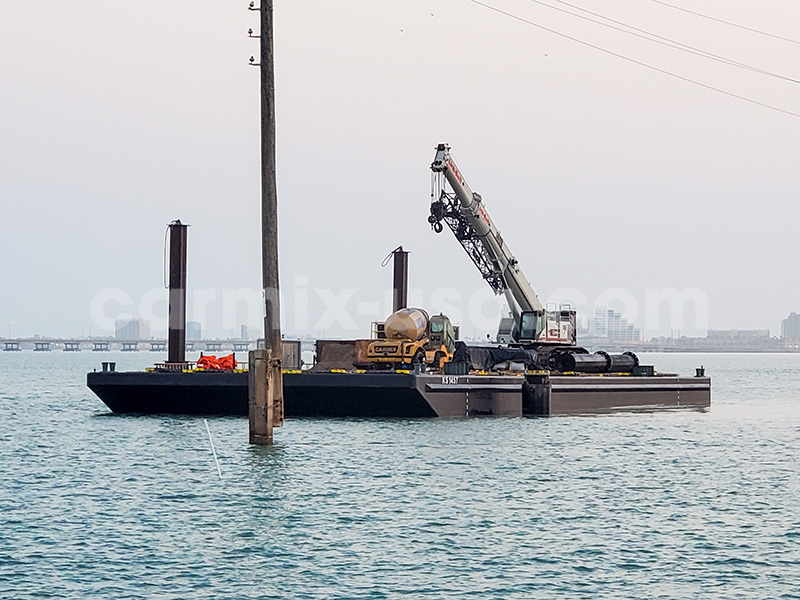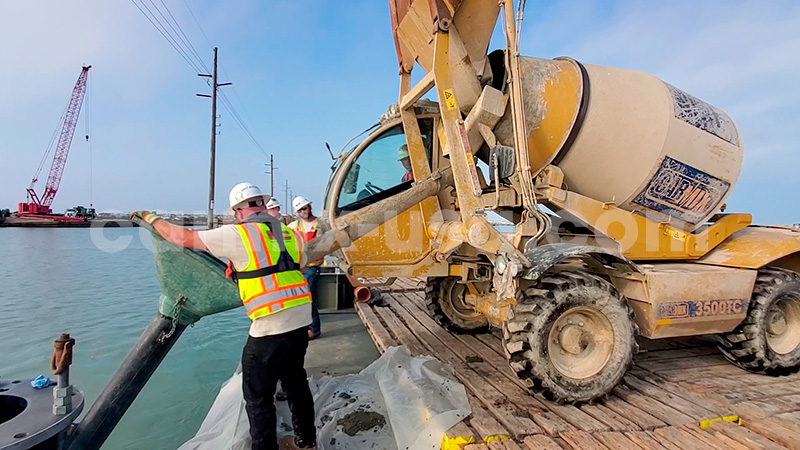Concreting a pile foundation at sea with Carmix
Carmix is a self-loading mixer that produced concrete blend in the open sea!
Neil Armstrong took a big step for mankind on the moon,as Carmix did from a barge onto an offshore platform and began producing the first cubic yards of concrete, a precious building material in the midst of sea.
It is a labor-intensive process that can take many months to concrete an offshore pile foundation. Every construction stage is lengthy: drilling underwater, installing sealed formwork, and making concrete mix.
Barge can’t deliver ready mix on site. It takes about a day to deliver only by sea. This doesn’t take into account duration of other stages: mortar transportation from plant to port, loading onto the barge, unloading on the platform. Сoncrete mixture will be in disrepair before it has even traveled halfway.

It is a time-consuming solution to produce concrete on site with your own stationary concrete plant, which would take more time to prepare, transport the equipment, and assemble.
First, the installation of a concrete plant would not have taken place as early as the approval stage. Environmentalists would not allow such a facility to be set up in open sea.
Secondly, the main problem of such specific facilities is limited space for placing the equipment.
Although the first aspect is already enough to not consider a concrete plant as a solution specifically for offshore construction, we will still give you an example for a visual comparison of all concrete production methods. In this way, you can understand exactly whether one or another solution is suitable for the conditions of your facility.
You will need more than 2,500 square feet of space for an average concrete plant with a capacity of 78 yd³/hour. Do not forget that concrete components are loaded with the help of additional equipment and ready blend is transported by mixers. Additional special-purpose equipment needs space for parking and driveway.

Is there so much space on a platform in the middle of the sea, where every square yard of land counts? It’s unlikely.
It is necessary to find suitable solutions for foundations construction of an offshore platform and other similar sites with limited space.
Volumetric mixers can be one of these solutions. Self-loading concrete mixer is compact. A 60yd³/hour model on a platform will take up considerably less space than a concrete plant – only 208 square feet.
There is only one nuance – additional equipment. Volumetric mixer still needs loaders and truck mixers or a concrete pump to load components and unload finished concrete.
Special-purpose equipment has the ability to direct conveyor belt of volumetric mixer in receiving hopper of concrete pump. Thus, unloading of ready-mixed concrete from hopper will not involve mixers and transportation of mortar on site. However, it is still necessary to load components into such special-purpose equipment with the help of loaders. It is impossible to allocate additional space for movement and parking of additional equipment with limited platform space.
Can concrete production take up even less space? Be assured – yes!

Self-loading concrete mixer is one of the best and optimal solutions to produce mixture quickly and of high quality even in offshore platform construction conditions. Carmix is fully automated: It loads materials with a bucket into a mixing drum and discharges mixture into the pouring area.
Carmix is a compact construction machinery, which accommodates all functions of the same concrete plant, and occupied area is comparable to loader. It is not necessary to allocate a large area for a concrete mixer. You can see how much space both machines take up on a platform.
A limited moving area is no problem for self-loading concrete mixers. Running characteristics of Carmix allow it to maneuver safely when there seems to be too little space for a relatively large machine.
Carmix has 4 steerable chassis, which makes it easy to access hard-to-reach areas.
The turning radius:
Inner – 5.9 feet
Outer – 13.1 feet
If it is not possible to drive up to site, then a concrete mixer can turn mixing drum to required side. Carmix does not move out of place during this process. Maximum swivel radius of drum is 300 degrees, which makes it possible to unload mix from almost all sides of Carmix.

This is a unique project for Carmix. No mobile concrete plant has ever produced mortar in the open sea in all years of experience of manufacturer, or official dealers in U.S.
Customer had the aim – to concrete 2 bored piles of 130 yd³ each.
Carmix is increasingly attracting interest from specialists in various fields of construction who does not work directly with concrete. It is sometimes difficult for such readers to imagine the full extent of concrete tasks at this site. Here’s an example: foundation of a small private residence 35 by 50 feet and 6 inches high requires 32 yd³.
It is about 4 times less than what is required for just one pile of an offshore platform!
Since this was the first time a concrete mixer had been operated on site like this, customer did not know exactly how long it would take to pour even one pile. They weren’t talking about Carmix output, but about the conditions at construction site: weather, speed of additional equipment, and loading of materials.
Carmix exceeded the plan and mixed concrete for 5 piles totaling about 650 yd³.
Production of various construction mixes can have both minor and huge negative impacts on the environment. Caution in making concrete right on site is especially important when construction takes place offshore.
There is no environmental damage when using Carmix. Self-loading concrete mixer is a “green” technology.

Making of concrete mix leaves “footprint” due to dust from mortar components and emissions from production.
Environmentalists would not approve installation and operation of a stationary concrete plant in the middle of the open sea as mentioned above. Harmful emissions could cause tremendous damage to the ecosystem.
When a concrete mixture is produced by a plant or volumetric mixer, dust from cement, sand and crushed stone can be dispersed up to a 15-mile radius due to logistics of components. Even if all precautions are followed and materials are stored in silos, harmful dust particles will spread through air during transport, loading into silos and into mixing hoppers.
Let’s take the most environmentally hazardous component of a mixture – cement. The chemical has an alkaline composition, so if it gets on the soil, plants, in the respiratory tracts of animals and people, it has an extremely negative effect.
Plants cannot photosynthesize under a thick layer of dust. Cement can lead to bronchitis and asthma when it deposited in human lungs.
Weight fraction of dust in cement is 4%. Volumetric mixer with a capacity of 60yd3/hour consumes up to 45 000 pounds of this substance each hour. Entire dust percentage can already be spread during transportation and loading phase. Consequently, up to 1800 pounds of cement will escape into the atmosphere and settle in space around construction site.

It is not possible to stop the bleeding of cement during construction process, but with Carmix damage to environment can be reduced to a minimum.
Concrete mixer is safer for sites in forested areas or the open sea than a volumetric mixer. Mixer is fully automated and feeds all components into the mixing drum by its own ladle. It is not necessary to transport components and load them into concrete plant’s hoppers with additional machinery. Cement dust is minimally dispersed during concrete production due to structure of the charging bucket.
In addition, Carmix is a green technology, because compared to diesel generator concrete plants, a self-loading concrete batching plant consumes much less fuel and pollutes the environment less with harmful air emissions.
| Carmix 5.5XL | Carmix 3500TC | Carmix 3.5ТТ | Carmix 2.5ТТ | Carmix One | |
| Fuel consumption | 2,4–3.2 gallons per hour | 2–2.5 gallons per hour | 2–2.5 gallons per hour | 1.8–2.4 gallons per hour | 1.3–1.8 gallons per hour |
Harmful emissions from concrete plant also include negative impact of loaders, mixers, which are not used during operation of concrete mixers with self-loading.
Carmix is equipped with Tier 5 eco standard engines and complies with the emission standards:
CH – up to 0.05 g/km
CO – up to 0.8 g/km
NOy – up to 0.06 g/km
The engines are equipped with an EGR system, which allows additional purification from nitrogen oxide, and filters are built in to eliminate soot emissions into the atmosphere.
Let’s go back to the beginning, concrete mixers arrived at site, but the first kneading of concrete mortar didn’t happen until a month later.
“So what was stopping us from starting to produce concrete?”
Basically, all long delays in concreting at the site were due to weather conditions. Often a storm would come up that would completely stop the construction process. Not only the production of concrete, but also the welding work that was done underwater.

So Carmix waited a few more days after the storm abated until the first pile was completely ready to be poured.
During the waiting period, a separate area was set up for concrete machines and the two mixers remained in place. They were only used to mix concrete and discharge it into the concrete pump. This is why they were positioned at the sides of the concrete pump, so as to minimize displacement on the platform as much as possible.
Concrete mix components were delivered in bulk bags for easy unloading. Sand and crushed stone were mixed together and unloaded from the same container. Cement, as the active substance, was stored in separate bags. All materials were intended to be unloaded directly into the mixing drum by means of a large crane.
Such a way of storage was most optimal in conditions of open space, strong winds and high humidity of the air. Otherwise, piles of sand and crushed stone would have been scattered by the storm.
Since there were two self-loading concrete mixers, they had to cope much faster with a construction volume of only 130yd³.
| Capacity | Carmix 3500TC | Carmix 2.5TT |
| per cycle | 4,58 yd³ | 3,9 yd³ |
| per hour | 13,7 yd³ | 11,7 yd³ |
| per shift | 100 yd³ | 87 yd³ |
The table shows capacity under ideal site conditions.Given that Carmix did not move there were other factors that affected duration of each mixing cycle.
Loading of aggregates was one factor that slowed down concrete production.
There was only one loading crane per two Carmix units, because of that mixing cycle could take up to 50 minutes, most of which was spent exactly on loading.
Carmix 3500TC took 35 to 50 minutes per batch. Carmix 2.5TT took 25 to 45 minutes per batch.
Operators followed a certain algorithm to reduce the time for other production steps. While one mixer is loading concrete, a second mixer is blending and emptying concrete into a pump. This has helped us optimize concreting process and cut our own time costs.
The first Carmix pile took 22 hours to pour. The fifth pile took 15 hours to pour.
In general, mobile concrete batching plants did their job in 5 working shifts, which stretched for almost a month.

